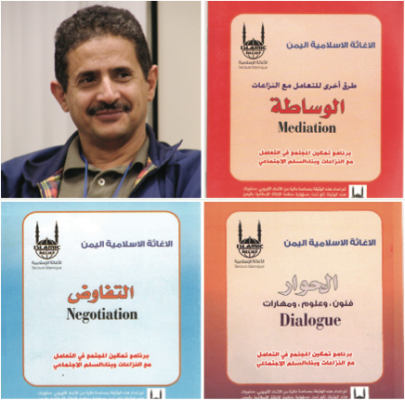
The news headlines from Yemen lately haven’t been pretty: bombings, shootings, insurgency, American drone strikes, dozens and dozens dead within the last few months alone. Far more have been killed in the unrest that has spread across the country since the Arab Spring in early 2011. In the absence of law and order across much of the country, several separatist movements remain active, and extremism appears to be on a continued rise.
“We have a culture of solving conflict, in some cases, with violence,” said Abdulaziz Saeed, MA ’05, who has consulted on various peacebuilding projects with the United Nations Development Programme (UNDP) and other organizations in Yemen. “There is a need for conflict transformation in Yemen.”
Now based in the capital city, Sanaa, with the Organization of Islamic Cooperation – with 57 member nations, the second-largest international organization after the UN – Saeed has been working to bring peace to his troubled country since finishing his graduate work at CJP eight years ago.
Conflict resolution workshops across Yemen
After his return to Yemen, Saeed spent six years working for the UK-based NGO, Islamic Relief Worldwide. During that time, one of his major accomplishments was the development of peacebuilding and conflict resolution workshops in 11 of Yemen’s 21 governorates, the country’s equivalent of states, where political disputes and conflicts over access to natural resources have led to violence.
According to Saeed, more than 2,000 people have taken part in 70 different trainings, which were funded by the British, Dutch and German governments. Participants included tribal and community leaders, imams and staff from local NGOs, as well as judges, police officers, prosecutors and other officials from local and national government offices and ministries.
Early in this process, a lack of good Arabic-language resources on the subject of conflict resolution presented Saeed with a challenge – one that he got around by writing a conflict resolution book of his own. He later wrote four booklets on negotiation, mediation, dialogue and reconciliation, as well as a training manual on the traditional Yemeni conflict resolution framework.
Rooted in Islamic values
Another challenge was finding the right trainers who understood conflict transformation and could base the workshops on Islamic values that support peacebuilding. After traveling widely, including visits to Egypt, Jordan and Lebanon, Saeed eventually found trainers who were capable of grounding their trainings in religious values and who – after some study and learning of their own – gained competence in the fundamentals of conflict transformation.
After these workshops, an “impact network” was established within each governorate, intended to provide communities with a new local resource to resolve conflicts nonviolently. A year later, Saeed and his colleagues checked back in with these impact networks to evaluate and learn from their various conflict resolution successes and failures. Representatives from the different governorates were asked to prepare presentations on their experiences, and then all met together to learn from each others’ experiences.
Looking at educating the youth
Once some stability returns to Yemen and funding becomes available, Saeed hopes to provide a second round of more advanced trainings. He is also working on an ambitious plan to introduce conflict transformation principles into Yemeni elementary school curriculums and university coursework.
An earlier peacebuilding project began soon after finishing his MA, when Saeed helped write the UNDP’s National Disaster Management Plan for Yemen. Here, he was able to include provisions for conflict transformation and trauma awareness training in the plan’s emergency and development programs. These, he said in an earlier communication with Peacebuilder magazine, were new concepts to others drafting the plan, requiring him to work hard to ensure their inclusion.
Having since moved on to other NGO work, Saeed noted that the UN “has been talking for a long, long time” about peacebuilding but has yet to achieve much in the way of on-the-ground results. In a deeply impoverished country like Yemen, where water is scarce and food insecurity, unemployment and illiteracy are high, “[peacebuilding] has to be a tangible thing,” said Saeed. Better healthcare, education and clean drinking water projects have to accompany the trainings and the talk and the theory.